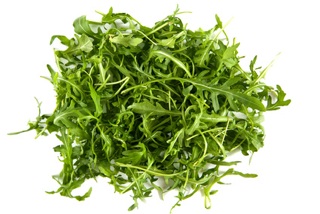- The health benefits of arugula are many. It looks very similar to lettuce and is part of the cruciferous vegetables, which are well known as nature’s potent multi-vitamins.
- Arugula makes a great choice for salad greens, because it is full of important antioxidants, vitamins, and minerals.
- Let’s look at the many health benefits of arugula.
- Bone health:
- It is rich in calcium, vitamin K, potassium, magnesium, manganese, and vitamin C which are all contributors to bone health.
- Arugula is also low in oxalates, which are substances that occur naturally in food and make it tough for the body to absorb calcium. As we know, calcium is a mineral that is essential to bone health.
- Vitamin K helps increase bone mineral density in people with osteoporosis, which in turn can prevent bone fractures.
- Cancer prevention:
- Arugula is part of the top 10 cancer fighting foods and for good reasons.
- It contains two cancer fighters called kaempferol and quercetin. Researchers have shown that diets containing arugula can reduce the risk of lung cancer.
- Like all cruciferous vegetables, arugula is also a great source of glucosinolates, which according to a study by the German Cancer Research Center helps prevent certain types of cancers.
- Eye health:
- Arugula contains carotenoids, which are well known to protect from age-related diseases like macular degeneration. Vitamin C acts as an antioxidant, reducing oxidative stress, which may help prevent cataracts.
- High in antioxidants:
- Antioxidants are substances that protect the body against the harmful effects of free radicals. Free radicals are molecules that are produced in the body when breaking down food, or with exposure to environmental factors such as tobacco smoke and radiation.
- Arugula is a great source of vitamins A, C, and K. These potent vitamins work as antioxidants in the body, eliminating free radical activity linked to chronic diseases.
Tip on how to use arugula:- Arugula is best used raw and in a salad, or mixed into pasta. We suggest Quinoa derived pasta.
- For the top 10 cancer fighting foods.
- For a body healer smoothie with arugula.
- Note: None of the information in our website is intended to diagnose, treat, cure or prevent any illness or disease. The content on our website is for educational purposes only.
- REFERENCES:
- 1. “Cruciferous Vegetables and Cancer Prevention.” National Cancer Institute. National Cancer Institute, 7 June 2012. Web. 6 July 2013.
- 2. “Vitamin K.” Harvard School of Public Health. Harvard School of Public Health, n.d. Web. 06 July 2013.
- 3. “Vitamin K Intake and Bone Mineral Density in Women and Men.” National Center for Biotechnology Information. U.S. National Library of Medicine, Feb. 2003. Web. 06 July 2013.
- 4. “Dietary Glucosinolate Intake and Risk of Prostate Cancer in the EPIC-Heidelberg Cohort Study.” National Center for Biotechnology Information. U.S. National Library of Medicine, 01 Nov. 2009. Web. 06 July 2013.
- 5. Li, William W., M.D. “Shopping for the Cancer Cure.” The Dr. Oz Show. Dr. Mehmet Oz, 25 May 2012. Web. 07 July 2013.6. Weber, P. “Vitamin K and Bone Health.” National Center for Biotechnology Information. U.S. National Library of Medicine, Nov.-Dec. 2001. Web. 07 July 2013.
7. “Food and Your Bones.” National Osteoporosis Foundation. National Osteoporosis Foundation, n.d. Web. 07 July 2013.

















